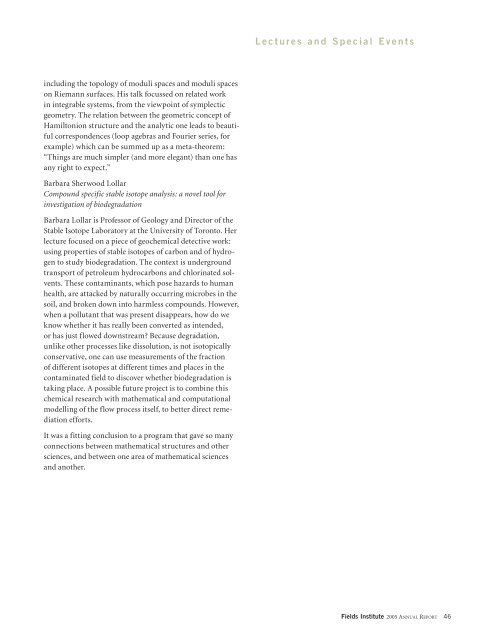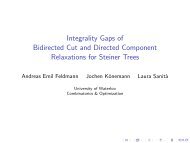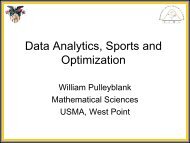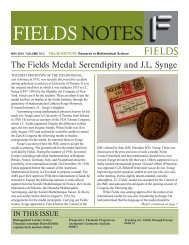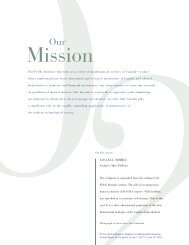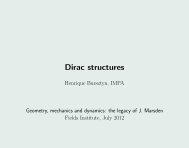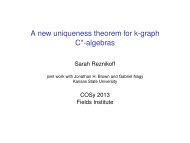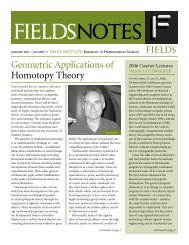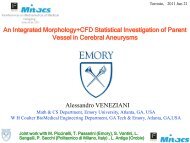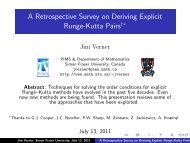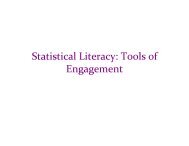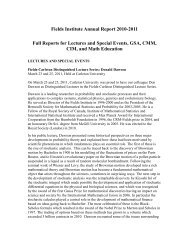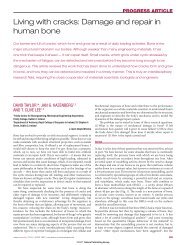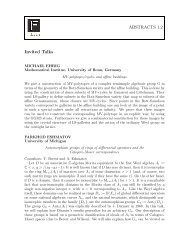Annual Report 2005 - Fields Institute - University of Toronto
Annual Report 2005 - Fields Institute - University of Toronto
Annual Report 2005 - Fields Institute - University of Toronto
You also want an ePaper? Increase the reach of your titles
YUMPU automatically turns print PDFs into web optimized ePapers that Google loves.
including the topology <strong>of</strong> moduli spaces and moduli spaces<br />
on Riemann surfaces. His talk focussed on related work<br />
in integrable systems, from the viewpoint <strong>of</strong> symplectic<br />
geometry. The relation between the geometric concept <strong>of</strong><br />
Hamiltonion structure and the analytic one leads to beautiful<br />
correspondences (loop agebras and Fourier series, for<br />
example) which can be summed up as a meta-theorem:<br />
“Things are much simpler (and more elegant) than one has<br />
any right to expect.”<br />
Barbara Sherwood Lollar<br />
Compound specific stable isotope analysis: a novel tool for<br />
investigation <strong>of</strong> biodegradation<br />
Barbara Lollar is Pr<strong>of</strong>essor <strong>of</strong> Geology and Director <strong>of</strong> the<br />
Stable Isotope Laboratory at the <strong>University</strong> <strong>of</strong> <strong>Toronto</strong>. Her<br />
lecture focused on a piece <strong>of</strong> geochemical detective work:<br />
using properties <strong>of</strong> stable isotopes <strong>of</strong> carbon and <strong>of</strong> hydrogen<br />
to study biodegradation. The context is underground<br />
transport <strong>of</strong> petroleum hydrocarbons and chlorinated solvents.<br />
These contaminants, which pose hazards to human<br />
health, are attacked by naturally occurring microbes in the<br />
soil, and broken down into harmless compounds. However,<br />
when a pollutant that was present disappears, how do we<br />
know whether it has really been converted as intended,<br />
or has just flowed downstream? Because degradation,<br />
unlike other processes like dissolution, is not isotopically<br />
conservative, one can use measurements <strong>of</strong> the fraction<br />
<strong>of</strong> different isotopes at different times and places in the<br />
contaminated field to discover whether biodegradation is<br />
taking place. A possible future project is to combine this<br />
chemical research with mathematical and computational<br />
modelling <strong>of</strong> the flow process itself, to better direct remediation<br />
efforts.<br />
It was a fitting conclusion to a program that gave so many<br />
connections between mathematical structures and other<br />
sciences, and between one area <strong>of</strong> mathematical sciences<br />
and another.<br />
L e c t u r e s a n d S p e c i a l E v e n t s<br />
<strong>Fields</strong> <strong>Institute</strong> <strong>2005</strong> ANNUAL REPORT 46


